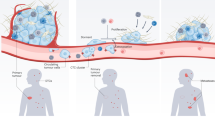Abstract
A technique using 'tritiated thymidine suicide' has been established as a means of studying the response to cytotoxic drugs of cells at different depths within multicellular tumour spheroids. Because of the characteristic spatial arrangement of cycling cells (mostly in the outer regions) and non-cycling cells (mostly at the inner regions) of spheroids, cells surviving after long term (24 h) exposure of spheroids to high doses of 3HTdR will be those located furthest from the surface. By comparing the drug response of cells from 3HTdR pre-treated and untreated spheroids, the individual response of total cells, cells near to the surface and cells lying deeper within the viable rim of spheroids can therefore be deduced. In this study, large spheroids of about 800 micron in diameter of a mouse mammary cell line, EMT6/Ca/VJAC, and of a human small cell lung cancer cell line, POC, have been used. Using clonogenic assay, the response of these two cell types to adriamycin (ADM), nitrogen mustard (HN2), CCNU and vincristine (VCR) (POC only) were measured. The preliminary part of this study has confirmed that the cells killed are those which incorporate 3HTdR during the DNA synthesis period; the cells killed are mainly located in the outer regions of spheroids i.e. surviving cells are mostly located in the inner part of the viable rim and 3HTdR pretreatment does not sensitise surviving cells to subsequent cytotoxic drug treatment. Results from large EMT6 spheroids agree with our previous findings (obtained using a selective disaggregation method) that cells in the outer regions of spheroids are more sensitive to ADM and HN2 than cells in the inner regions whilst the opposite is true for CCNU. For POC spheroids, cells in the outer region of spheroids are more sensitive to ADM and VCR than cells in the inner region whilst a reverse trend is seen for the response to CCNU. The response to HN2 is similar at all depths. Amongst the factors governing the response of cells in spheroids to cytotoxic drugs, the responses to ADM and VCR are thought to be largely dictated by cell cycle distribution and limited drug penetrability, whilst for HN2 the response may be determined by the factor of cell cycle distribution. For CCNU, we believe that the cellular response is largely dependent upon microenvironmental factors prevailing within spheroids.
This is a preview of subscription content, access via your institution
Access options
Subscribe to this journal
Receive 24 print issues and online access
$259.00 per year
only $10.79 per issue
Buy this article
- Purchase on Springer Link
- Instant access to full article PDF
Prices may be subject to local taxes which are calculated during checkout
Similar content being viewed by others
Rights and permissions
About this article
Cite this article
Kwok, T., Twentyman, P. Use of a tritiated thymidine suicide technique in the study of the cytotoxic drug response of cells located at different depths within multicellular spheroids. Br J Cancer 55, 367–374 (1987). https://doi.org/10.1038/bjc.1987.74
Issue Date:
DOI: https://doi.org/10.1038/bjc.1987.74



